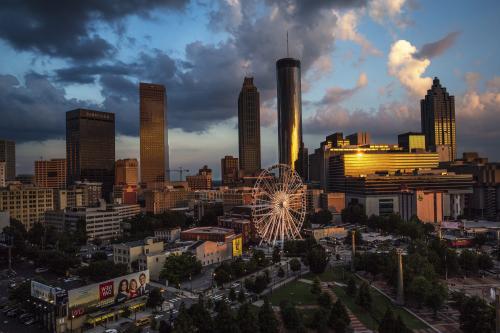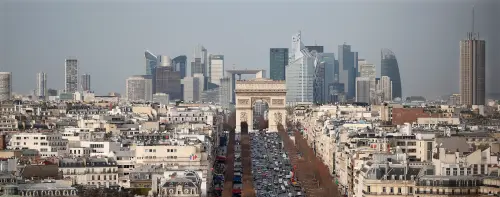The new book, “Global Cities: A Short History,” will be published by the Brookings Institution Press on November 28, 2016.
Writing a short history of global cities is much harder than writing a long one. Starting with the ancient equation between cities and trade, we make the observation that the imperative to trade creates the conditions for urbanization, and trading cities are forced to innovate to stay ahead. Thus, trade fosters city growth, and trading cities foster innovation in transport, finance, law, language, and communication. This observation proves true not just in the recent past, but also in the distant and ancient trade routes where cities grew. Ancient innovations, from ports to currencies to maps to transport to insurance and banking, propelled the scale of trade forwards, and enabled those cities to grow and flourish.
| Era | Example Cities | Innovations |
| 1300 BC Phoenicians | Tyre, Syracuse, Carthage | Ship Building, Spread of Literacy |
| 500 BC Persian Royal Road | Babylon, Susa, Ephesus | Road Building, trade systems |
| 400 BC The Silk Roads | Ctesiphon, Samarkand, Balkh | Caravans, paper, algebra, gunpowder, banking, medicine |
| 1300 AD The Mediterranean | Venice, Barcelona, Genoa. | Mathematics, Insurance, Cartography |
| 1300 AD South East Asia | Canton, Melacca, Surabaya | Navigation, Spice Trade, Cuisine |
| 1300 AD Hanseatic League | Hamburg, Lubeck, Bruges | Commercial organisation, Shipbuilding, Banking |
Five traits of global cities
These trade routes fostered city development. And the cities they encouraged came to have five observable traits that repeated themselves from one cycle to another, over the past 5,000 years:
- Trade and connectivity that foster city development and draw people in
- Openness, diverse and entrepreneurial populations that spawn sharing of knowledge and ideas
- Innovation and the influence that comes from invention and advance
- Discovery of new markets that is propelled these inventions
- The ability to take advantage from geopolitical change, being ready for the next cycle and new markets and inventions
These five elements are not a definition of global cities. This book is not about theory, but a short history. But we do want to observe that these five elements appear as a common thread between the globalizing cities of today and the trading cities of the past.
The next observation is that clear cycles of trade development are observable, and each cycle brings with it a new wave of globalizing cities. The cycles and waves link closely with what we already know about the larger cycles of technology and trade development.
In the current cycle, post 2010, the new wave of globalizing cities contains some distinctive types. We are familiar with the cities that have already been engaged in successful transition to globalization in the 20th century, by specializing in the globalizing industries of that period: finance, professional and business services, media and communication. These cities are all in transition towards some of the newer globalizing sectors in Digital Technologies, Life Science, Climate, Energy and Water, Urban Services and Infrastructure, Materials, and Robotics. They are joined by two other large groups of cities: the leading cities in the fastest growing and largest economies, from Shanghai and Beijing to Sao Paulo, Buenos Aires, Lagos, and Johannesburg. These cities specialize in the HQ, advanced services, and trade functions through which their national economies develop international dimensions. They are joined by another group of cities that were also part of this wave. New, specialized and high performing medium-sized cities are leapfrogging the national dimension and rapidly internationalizing their economies and population. These cities – such as San Diego, Tel Aviv and Auckland – are playing important roles in the next cycle of innovation, higher education and international investment.
Five paths of global cities
Today, more cities than ever are able to plot their own course and develop global reach. They are being more purposeful about their advantages, and are grasping the global opportunity at key moments. These cities are growing through very different pathways. We can observe five paths.
For one group of cities, trade has been the critical pathway, and their trading communities are overseeing the renewal and enhancement of their most important assets. Historic port cities such as Hamburg and Rotterdam are pursuing an innovation-led growth model to ensure their economies remain resilient to changing global demand.
Others are geopolitical opportunists, profiting from the declining fortunes of neighbors, or their sudden proximity to booming markets. In the past, this included Singapore and Munich, and today this group includes Shenzhen and Warsaw.
A third set of cities is leveraging their inherited R&D, technology and tradable knowledge to provide initially basic services in global value chains, before moving into higher value activities, as Nanjing and Bangalore have done.
Then there are those cities–like Santiago and Colombo–that are championed by national government, often after periods of political transition.
And finally, we may observe the cities whose entry or re-entry into the global system has been catalyzed by the arrival of international events or institutions, as with Vienna and Nairobi’s United Nations functions, for example.
These five pathways shape many of the journeys, path dependencies and future opportunities that cities will experience in the years and decades ahead. Despite the high-profile internal and external threats these cities all face, it is very likely that this wave of globalizing cities, semi-detached from trends in their national economy, will continue to grow. With every passing year, more cities across global regions (especially in the Asia-Pacific, Africa and Latin America) are acquiring international functions and positioning their tradable sectors for global exchange.
We should not be surprised if this trend continues given the scale of global urbanization, the demand of the global economy for dynamic urban agglomerations, and the impulse for diversification away from the established cities, whether by talent, capital, technology, or firms. The next cycles of infrastructure investment and connectivity will also be a major driver of global cities, providing access to global markets, and enabling the “functional federation” of cities across political borders, through infrastructure and technology systems.
Strategic imperatives for a global future
What does this change in functionality and connectivity mean for global cities? It means they all face three strategic imperatives. First, to sustain their global roles they have to find a way to compete and to lead. Accidental success has to be followed by deliberate co-ordination and promotion if cities are to compete with their peers, neighbors, and global pace-setters. Usually this requires a competitive mindset among leaders and a desire to innovate, benchmark, develop strategies, and boldly deploy resources.
Second, global cities inevitably have to tackle the internal consequences of success and growth. The pace and scale of their development usually supersedes pre-existing systems of investment and delivery, leading to deficits and acute problems of affordability, congestion and inequality. These issues manifest themselves differently everywhere, but to be confronted usually require a step change in governance, fiscal capacity, sectoral integration, and regulatory frameworks.
The third and perhaps most fundamental challenge that globalizing cities face relates to the relationship with their nation state. The positive and negative externalities of global cities upon their national economies and societies has become hotly debated in many countries. In the future, the globalizing cities will need to articulate their value to the rest of their nation more effectively, recruit the support of higher tiers of government to their long term strategies, and align wider systems of governance to the opportunities that global cities bring to other cities and towns within the same domestic economy.
All global cities will view these imperatives from their own starting points and in very different institutional conditions. Some may choose to prioritize convening and coordinating the diverse institutional and leadership landscape in their city. Others may enter a long-term effort to win the hearts and minds of those in national government and the electorates it represents. It is likely that many will pursue deeper partnerships between business and governing institutions, and seek to optimize private-sector engagement. And we may even see a few cities consider ‘going it alone,’ as national governments fail to deliver necessary reforms or investment.
As global cities find their own way, and as the next cycles of globalization, trade relationships, and infrastructure investments play out, a new system of global, trading, and connected cities will come into being. And while we may not be sure how it will look, it will no doubt share common threads with the past waves and networks of global cities throughout their short history.







Commentary
Global cities: A short history
November 28, 2016